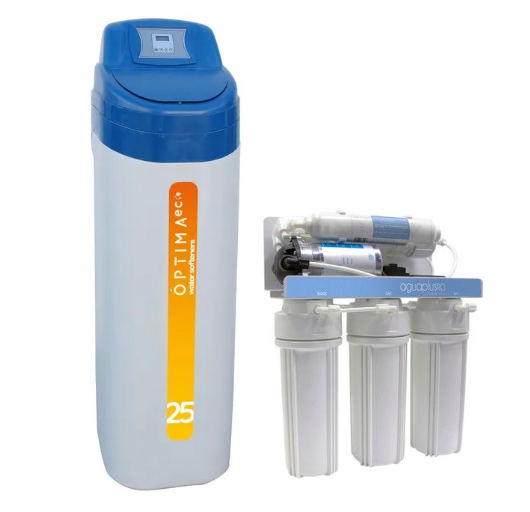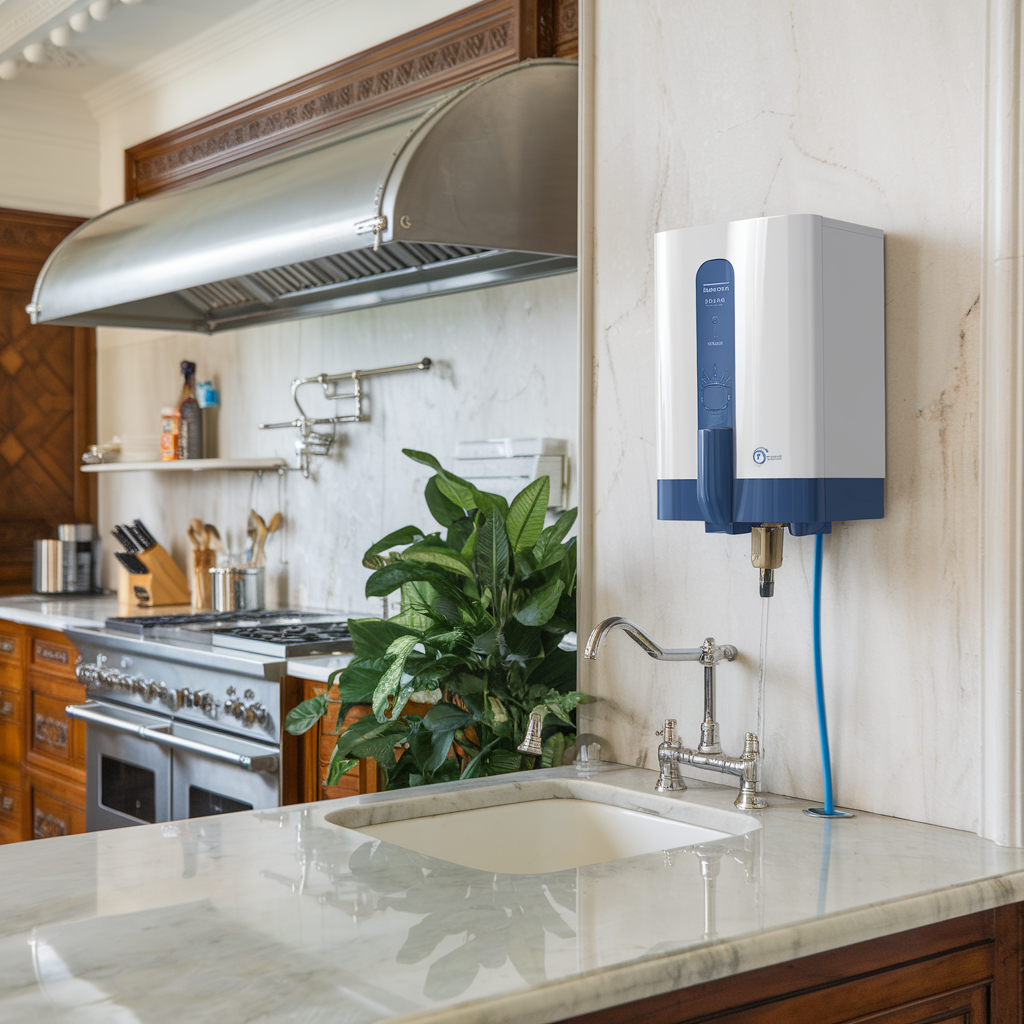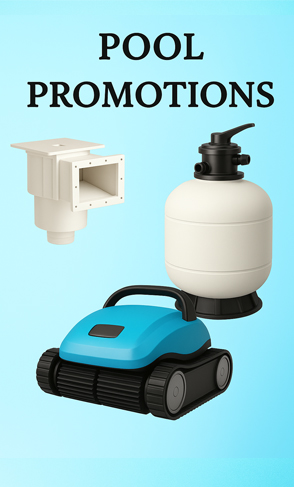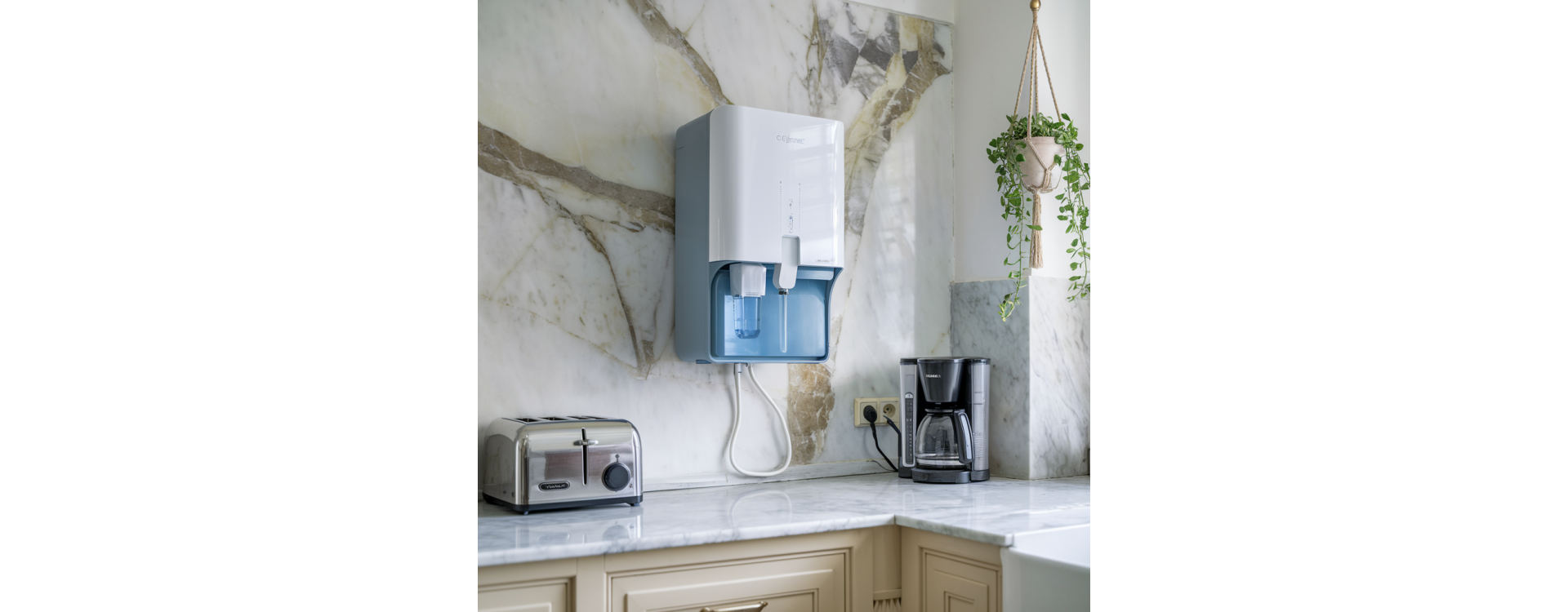Complete guide to water softeners and water purification methods
Ensuring clean, impurity-free water is essential for well-being in your home. In this guide, we'll explore everything related to installing a water softener, how it works, and the different methods for purifying water, including techniques such as purifying water with bleach and how to purify seawater. We'll also answer common questions such as why the water softener keeps filling up with water.
Automatic water softener and reverse osmosis system: the best option for purifying water at home.
This pack automatic water softener 25-liter water heater with a 5-stage reverse osmosis system, offering a complete solution for purifying water at home. Its advanced design guarantees water free of limescale, sediment, and impurities, ideal for daily consumption and home appliance maintenance.

The automatic water softener removes water hardness through an ion exchange process, reducing limescale buildup in pipes, faucets, and appliances. Its automatic regeneration system makes maintenance easy, ensuring efficient operation without the need for constant intervention.
He reverse osmosis purifier equipment It complements the water softener by providing an additional level of purification. With its five filtration stages, it removes chlorine, heavy metals, bacteria, and other contaminants, improving the taste and quality of the water. It also includes a post-filter that optimizes the pH, ensuring more balanced and healthier water.
The main features of this pack include:
- Water softener capacity: 25 liters, ideal for medium to large sized homes.
- Automatic system: Programmable regeneration for easy maintenance.
- 5-stage reverse osmosis: Complete filtration for high quality drinking water.
- Easy installation: Designed to fit any home without complex modifications.
- Energy efficiency: Low salt and water consumption during the regeneration process.
- Protection for household appliances: Prevents damage to boilers, washing machines and dishwashers by removing limescale.
This package not only guarantees pure, impurity-free water, but also contributes to long-term savings by reducing wear and tear on household appliances and improving energy efficiency. It's the best option for those seeking quality, convenience, and safety in domestic water treatment.
Water softener installation: steps and recommendations
Installing a water softener is a simple process if you follow the proper steps. A water softener removes limescale from your water, improving its quality and protecting your pipes and appliances.
When installing it, it's essential to choose a location close to the main water supply. This ensures that the entire home system benefits from the treated water. Make sure you have an electrical connection and drainage for the regeneration system. It's also advisable to hire a professional if you don't have previous experience.
The benefits of installing a water softener include:
- Extend the life of household appliances.
- Reduce maintenance costs.
- Improve energy efficiency by preventing limescale buildup.
Once your water softener is installed, it's important to perform periodic checks to ensure optimal performance. Checking the salt levels and cleaning the system will help keep it in perfect condition.
Installation Considerations
It's essential to analyze your water pressure before installing a water softener. An inadequate pressure level could affect the system's performance. It's also important to ensure that the selected location has access to drainage and electricity for the system to function properly.
A common mistake is not performing an initial flush after installation. This step is essential to clean the system and remove any residue before beginning regular use. Following these recommendations will help extend the life of your water softener.

Water softener: how it works: basic principles
Understanding how a water softener works allows you to make the most of its capabilities. This device uses an ion exchange process to remove minerals responsible for water hardness, such as calcium and magnesium.
The water passes through a resin charged with sodium ions, where the exchange takes place. The hard minerals are then trapped, and the water is released softened. During the regeneration process, the system removes the retained minerals and replenishes the sodium in the resin.
The way a water softener works is based on maintaining a balance between efficiency and maintenance, so the salt level in the tank must be monitored regularly. This process ensures that the system continues to operate efficiently over time.
Benefits of the process
The ion exchange process not only improves water quality but also reduces limescale buildup in pipes and appliances. This prolongs the lifespan of appliances and reduces maintenance costs. In addition, softened water improves the performance of detergents, allowing for better washing of clothes and dishes.
Why does the water softener fill with water?
A common problem many people face is wondering why their water softener keeps filling up with water. This can happen for a variety of reasons, from incorrect settings to blockages in the drain lines.
The most common causes include:
- Failure in the control valve that regulates the flow of water.
- Blockage in the drain line that prevents proper drainage.
- Excess salt accumulated in the tank.
To prevent the water softener from overfilling with water, it's recommended to perform periodic inspections, clean the components, and adjust the settings according to your home's specific needs. If the problem persists, it may be necessary to contact a specialized technician.
Solutions to excess water
If the water softener fills with water repeatedly, it is recommended to check that the drain lines are free of obstructions. It is also important to check the condition of the control valve, as a malfunction can impede the regeneration process. Replacing defective parts ensures efficient operation and prevents future problems.
How to purify water at home
Knowing how to purify water at home is essential to ensure safe drinking. There are various methods for removing impurities and microorganisms from water, adapting to different needs and budgets.
Common methods for purifying water include:
- Use of activated carbon filters to remove chemical contaminants.
- Boil water for at least 10 minutes to kill bacteria and viruses.
- Reverse osmosis systems to remove impurities at the molecular level.
- Chemical treatments such as the use of chlorine or bleach.
The ideal option will depend on the initial quality of the water and its intended use. If the goal is daily consumption, a home filter may be sufficient. However, for emergency situations, methods such as boiling water may be more practical.
When it comes to water purification, it's important to combine techniques if the water is highly contaminated. Filtering out sediment first and then applying chemical disinfection can ensure better results.
Complementary methods
In addition to the aforementioned methods, the use of UV lamps for disinfection has become popular. These lamps eliminate microorganisms without affecting the taste of the water. Another option is the use of purification tablets, especially useful in emergency situations.
Purifying water with bleach: a safe and effective method
One of the most accessible methods for purifying water with bleach is to add a small amount of unscented household bleach. This process is useful in emergencies or when other sources of drinking water are unavailable.
Steps to purify water with bleach:
- Filter the water to remove visible sediment.
- Add 8 drops of bleach for every liter of clear water or 16 drops if the water is cloudy.
- Mix well and let it sit for 30 minutes.
- Check for a faint chlorine smell. If not, repeat the process.
This method is effective at eliminating bacteria and viruses, but it does not eliminate chemical contaminants or heavy metals. It is ideal as a temporary measure in emergency situations.
How to purify seawater safely and efficiently
Purifying seawater is essential for converting it into drinking water, especially in situations where freshwater sources are unavailable. There are several effective methods that remove salt and impurities, making the water suitable for human consumption.
Methods for purifying seawater
- Solar distillation: It uses the sun's energy to evaporate water and separate the salt. The steam condenses on a clean surface, leaving the water ready to drink. It's a simple method, although it can be slow.
- Heat distillation: It boils seawater and collects the steam in a separate container. This process removes salt and most contaminants, efficiently producing purified water.
- Reverse osmosis: It uses special membranes to filter out salt and other impurities. It's one of the most advanced and efficient methods, but requires specific equipment and electricity.
- Portable filtration systems: They are compact devices that combine mechanical and chemical filtration. They are designed for emergency situations and are easy to transport.
- Filtration by nanofiltration membranes: This process is similar to reverse osmosis, but cheaper and faster. It significantly reduces the salt concentration in the water.
Discover all the home products at The Garden Store
In The Garden Shop, We specialize in offering high-quality home products designed to make your life more comfortable and efficient. We offer water treatment solutions, such as automatic water softeners and reverse osmosis systems, ideal for ensuring pure water and protecting your appliances.












Leave a comment